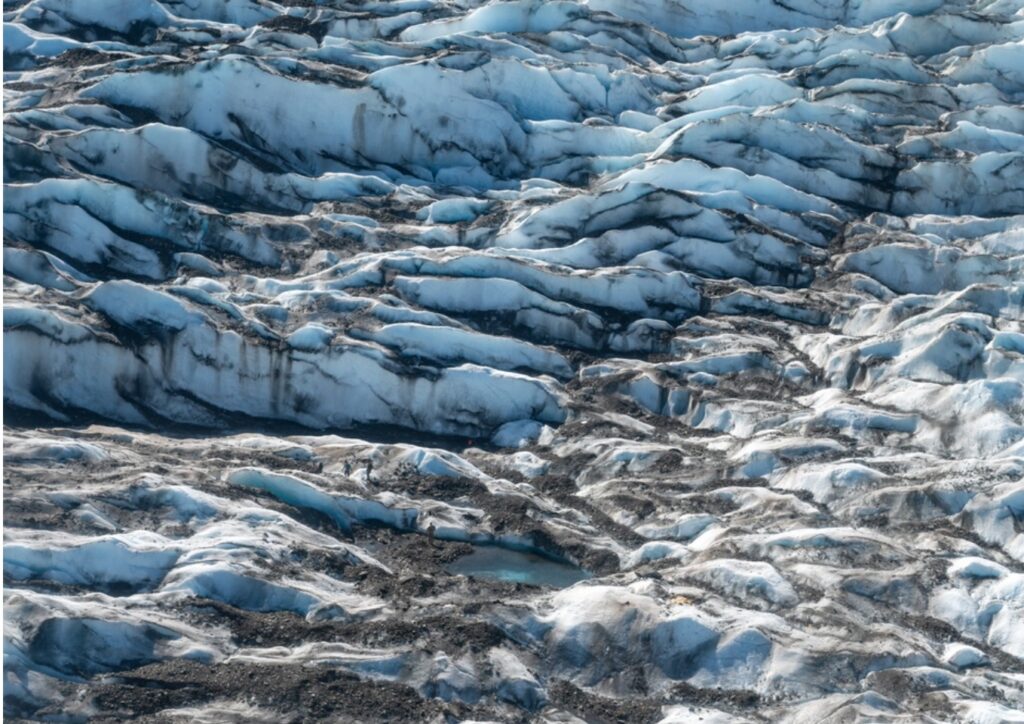
The annual recovery mission at the site of one of the deadliest military aviation accidents in Alaska’s history continued this June, more than 72 years after the crash of a U.S. Air Force C-124 Globemaster II into Mount Gannett. to date 49 of the 52 who perished in that crash have had their remains recovered.
On Nov. 22, 1952, a massive transport aircraft known as “Old Shaky” was flying from McChord Air Force Base in Washington state to Elmendorf Air Force Base near Anchorage when it crashed into the 9,629-foot mountain in the Chugach Range.
The plane was carrying 11 crew members and 41 passengers, including service members from the Air Force, Army, Navy, and Marine Corps. All 52 were killed.
Flying at night and navigating through severe weather with strong winds and heavy cloud cover, the aircraft was off course when it hit the mountain at full speed. A Northwest Orient Airlines pilot reported receiving a final message from the C-124’s pilot: “As long as we have to land, we might as well land here.” The wreckage was quickly buried by snow and avalanches triggered by the impact.
Initial search and rescue operations involved 32 military aircraft and four Coast Guard vessels. On Nov. 28, 1952, Terris Moore of the Fairbanks Civil Air Patrol and Lt. Thomas Sullivan of the 10th Air Rescue Squadron spotted the tail section of the aircraft at about 8,100 feet on what they recorded as Surprise Glacier, south of Mount Gannett. Recovery was deemed impossible due to dangerous conditions and deep snow. The mission was called off within a week, and the wreckage became entombed in the ice.
For decades, the crash site remained hidden within the shifting ice of Colony Glacier, which carried the wreckage some 12 to 14 miles over the years toward Lake George. Some of the wreckage emerged and was discovered on June 9, 2012, when a UH-60 Black Hawk crew from the Alaska National Guard spotted a yellow life raft during a training mission. Investigators confirmed the raft and other debris were from the lost C-124.
Since 2012, Operation Colony Glacier has taken place each summer, with teams from Alaskan Command, Alaska National Guard, U.S. Army Alaska, the 11th Airborne Division, Air Force Mortuary Affairs Operations, and the Armed Forces Medical Examiner System working to recover human remains and personal effects.
The effort is timed for early summer when conditions on the glacier are most stable and before the ice carries wreckage farther downstream or into crevasses.
Items recovered have included personal belongings such as shoes, a flight suit, chess pieces, a 1944 map, 3-cent postage stamps, a Buddha figurine, a 1952 Mass schedule, and a camera.
By 2021, teams had recovered over 460 bags of human remains and nearly 100 bags of personal effects. Glacier movement, estimated at 200 to 300 meters per year, continues to uncover and endanger the remaining material.
By 2019, 40 of the 52 victims had been identified using DNA analysis conducted at Dover Air Force Base. Among those identified were Air Force Staff Sgt. Eugene Costley in 2018, and four other airmen in 2016: Capt. Kenneth Duvall, 2nd Lt. Robert Moon, and Airmen 2nd Class Thomas Condon and Conrad Sprague.
As of June 2025, 49 of the 52 have been positively identified.

This summer’s mission continued the tradition of careful recovery, carried out by personnel from Alaskan Command, the 11th Airborne Division, Alaska National Guard, Air Force Mortuary Affairs Operations, the Armed Forces Medical Examiner System, US Army Alaska, the 673rd Air Base Wing, the 3rd Wing, and Detachment 1 of the 66th Training Squadron.
On June 12, US Air Force Col. Kevin Heath, Director of Operations at Alaskan Command, and Col. Jason White, deputy commander of the 611th Air Operations Center, toured the Colony Glacier site with Capt. Travis Lockwood, Operation Colony Glacier’s ground commander.
Operation Colony Glacier continues to serve as a testament to the military’s enduring commitment to account for its fallen, bringing long-awaited closure to families and honoring those who perished in service.
A tremendous operation.
There was also a Northwest Orient crash on Mt. Sanford a few years earlier involving another large transport. The crew was flying her out of China with a refuel stop in Anchorage. All were killed as the plane slammed onto a glacier halfway up Sanford. There were actually some eye witnesses in Gienallen who saw the nighttime fireball. Rumor had it that the plane was transporting a huge quantity of gold from China to the US, but this was never confirmed.
Read the book, “Letters from the Globemaster Families.” The weather was not particularly bad although the winds aloft were higher than forecast, and the radio message regarding an emergency landing was not from the C-124. They were simply off course and hit Mount Gannett at their cruise altitude, a classic case of “controlled flight into terrain (CFIT).”
Thanks for telling our story. We look froward to the day when 52 out of 52 has been ID and turned home to their family. It has been a long fight for me and now honored they are coming home. There is a book out there Gifts From a Glacier: The Quest for an American Flag and 52 Souls. Please take a moment to read.
Follow the families story on Facebook ‘https://www.facebook.com/MissingC124